Antidepressant Comparison Tool
Compare Antidepressants
Select the antidepressants you'd like to compare based on key criteria: efficacy, side effects, onset of action, drug interactions, and cost.
Comparison Results
| Criteria | Celexa | Escitalopram | Fluoxetine | Sertraline | Venlafaxine | Bupropion | Mirtazapine |
|---|
Important Note: This tool provides general information for comparison purposes only. Always consult with a healthcare provider to determine the appropriate medication for your individual situation.
If you're weighing Celexa against other options, this guide breaks it down.
Key Takeaways
- Celexa (citalopram) is an SSRI with a clean side‑effect profile at doses ≤20 mg/day.
- Escitalopram offers slightly higher potency, while fluoxetine has the longest half‑life.
- Venlafaxine (SNRI) works faster for severe anxiety but carries higher blood‑pressure risks.
- Bupropion is non‑serotonergic, useful for patients who struggle with sexual side effects.
- Cost and insurance coverage often tip the decision in real‑world prescribing.
What Is Celexa (Citalopram)?
When treating depression, Celexa is the brand name for citalopram, a selective serotonin reuptake inhibitor (SSRI) approved by the FDA for major depressive disorder. It increases serotonin levels in the synaptic cleft by blocking the serotonin transporter (SERT), which helps lift mood over several weeks.
Typical starting dose is 10 mg once daily, titrated to 20 mg. Doses above 20 mg are discouraged in patients over 60 because of QT‑interval prolongation risk. Citalopram is metabolized primarily by the liver enzyme CYP2C19 and excreted unchanged in urine.
Common Antidepressant Alternatives
Below is a snapshot of the most frequently prescribed alternatives, each with its own pharmacologic class and clinical niche.
- Fluoxetine - an SSRI known for its activating effect and long half‑life (4‑6 days).
- Sertraline - another SSRI, a bit more potent for anxiety and obsessive‑compulsive symptoms.
- Escitalopram - the S‑enantiomer of citalopram, offering higher serotonin reuptake inhibition at lower doses.
- Venlafaxine - an SNRI that hits both serotonin and norepinephrine, useful for severe or treatment‑resistant cases.
- Bupropion - a norepinephrine‑dopamine reuptake inhibitor (NDRI) that avoids most sexual side effects.
- Mirtazapine - a noradrenergic and specific serotonergic antidepressant (NaSSA) that can improve sleep and appetite.
How We Compare Antidepressants
To make a fair call, clinicians usually weigh five core criteria:
- Efficacy: How well the drug lifts depressive scores (e.g., HAM‑D, PHQ‑9) in trials.
- Onset of Action: Weeks until noticeable symptom relief.
- Side‑Effect Profile: Sexual dysfunction, weight change, insomnia, gastrointestinal upset, cardiovascular impact.
- Drug Interactions: CYP enzyme involvement, risk of serotonin syndrome.
- Cost & Accessibility: Generic availability, insurance tier.
Applying these lenses to each medication helps you see where Celexa fits.
Side‑Effect Snapshot
| Drug | Sexual Dysfunction | Weight Change | Insomnia | QT‑Prolongation | Blood‑Pressure Rise |
|---|---|---|---|---|---|
| Celexa (citalopram) | Moderate (≈15%) | Neutral | Low | Only >40 mg/day | None |
| Escitalopram | Low (≈10%) | Neutral | Low | Rare | None |
| Fluoxetine | Low‑Moderate (≈12%) | Weight loss (≤5% body weight) | High (activating) | None | None |
| Sertraline | Moderate (≈14%) | Neutral | Low‑Moderate | None | None |
| Venlafaxine | Low (≈8%) | Weight loss | Moderate | None | ↑ BP at >225 mg |
| Bupropion | Very low | Weight loss | Low | None | None |
When Celexa Is a Good Fit
Celexa shines in patients who need a straightforward SSRI without extra activation or sedative effects. Its once‑daily dosing and lack of significant drug‑enzyme induction make it low‑maintenance.
Typical scenarios:
- Middle‑aged adults with mild‑to‑moderate major depressive disorder who are not on other QT‑prolonging drugs.
- Patients who have tried fluoxetine or sertraline and experienced excessive insomnia or agitation.
- Individuals who value a medication that can be stopped relatively quickly (half‑life ≈35 hours) compared with fluoxetine’s weeks‑long washout.
When One of the Alternatives Might Be Better
Every drug has a niche. Here are quick decision rules:
- Escitalopram: Choose if you need the highest serotonin reuptake inhibition with the lowest dose (10 mg ≈ 20 mg citalopram) and want fewer sexual side effects.
- Fluoxetine: Ideal for patients who forget doses because the drug sticks around for weeks, or when an activating profile helps counter fatigue.
- Sertraline: Preferred for comorbid anxiety, OCD, or PTSD because of its robust anxiolytic effect.
- Venlafaxine: Use in treatment‑resistant depression or when prominent pain symptoms coexist, but monitor blood pressure.
- Bupropion: Best for patients plagued by sexual dysfunction on SSRIs or who also want to quit smoking.
- Mirtazapine: Consider for depressed patients who suffer from insomnia or weight loss, as it often improves sleep and appetite.
Cost and Insurance Realities (2025)
Generic citalopram tablets cost around AUD 0.30 per 10 mg tablet in Australia, making it one of the cheapest SSRIs. Generic escitalopram is slightly pricier (≈AUD 0.45). Fluoxetine and sertraline sit near AUD 0.35‑0.40. Venlafaxine and bupropion are a bit higher, often AUD 0.60‑0.80, because of patent extensions in some markets. These price gaps can influence prescribing, especially in public health schemes.
Monitoring and Safety Tips
Regardless of which drug you pick, follow these basic safety checkpoints:
- Baseline ECG for patients over 60 or with cardiac risk factors before starting Celexa >20 mg/day.
- Check CYP2C19 genotype if you suspect poor metabolism; poor metabolizers may need dose reduction.
- Screen for serotonergic co‑medications (e.g., tramadol, triptans) to avoid serotonin syndrome.
- Reassess mood and side‑effects after 4-6 weeks; adjust dose or switch if no improvement.
- Educate patients about the “activation syndrome” that can appear early with SSRIs - increased anxiety, restlessness, or suicidal thoughts.
Bottom Line
Celexa remains a solid, cost‑effective SSRI with a clean interaction profile. Its chief competitors-escitalopram for potency, fluoxetine for activation, sertraline for anxiety, venlafaxine for pain, bupropion for sexual side‑effects, and mirtazapine for sleep-each fill a specific therapeutic gap.
Choosing the right medication is less about which one is “best” in absolute terms and more about matching the drug’s strengths to the patient’s symptom profile, comorbidities, and lifestyle.
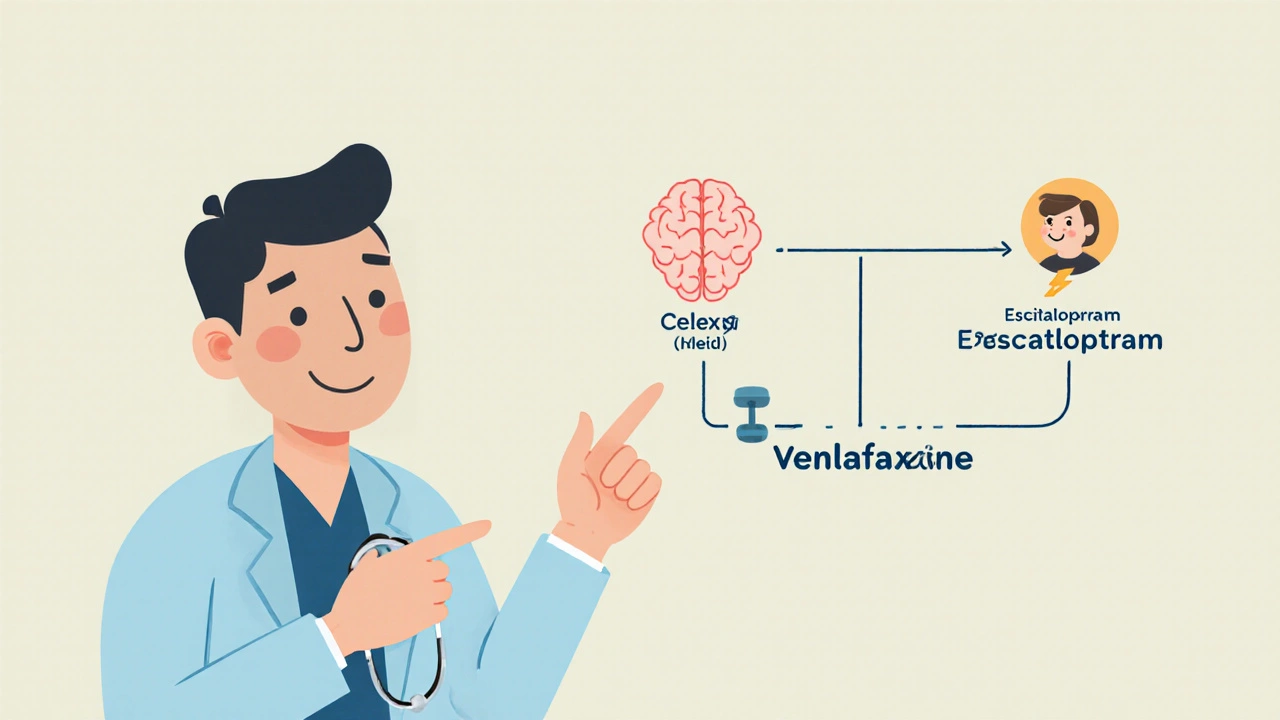
How long does it take for Celexa to start working?
Most people notice mood improvement after 2‑4 weeks, but the full antidepressant effect may take up to 8 weeks. Early weeks can bring side‑effects before the benefit kicks in.
Can I take Celexa with other antidepressants?
Combining two serotonergic agents (e.g., Celexa + another SSRI) raises the risk of serotonin syndrome and is generally avoided. Switching requires a washout period of at least 5 days for most SSRIs.
Is Celexa safe during pregnancy?
Citalopram is classified as Pregnancy Category C in Australia. It should be used only if the potential benefit justifies the risk. Discuss options with an OB‑GYN.
What should I do if I miss a dose?
Take the missed tablet as soon as you remember, unless it’s almost time for the next dose. In that case, skip the missed one-don’t double up.
Are there natural alternatives to Celexa?
Lifestyle changes (regular exercise, adequate sleep, CBT) can complement or, in mild cases, replace medication. However, for moderate‑to‑severe depression, evidence supports pharmacologic treatment.

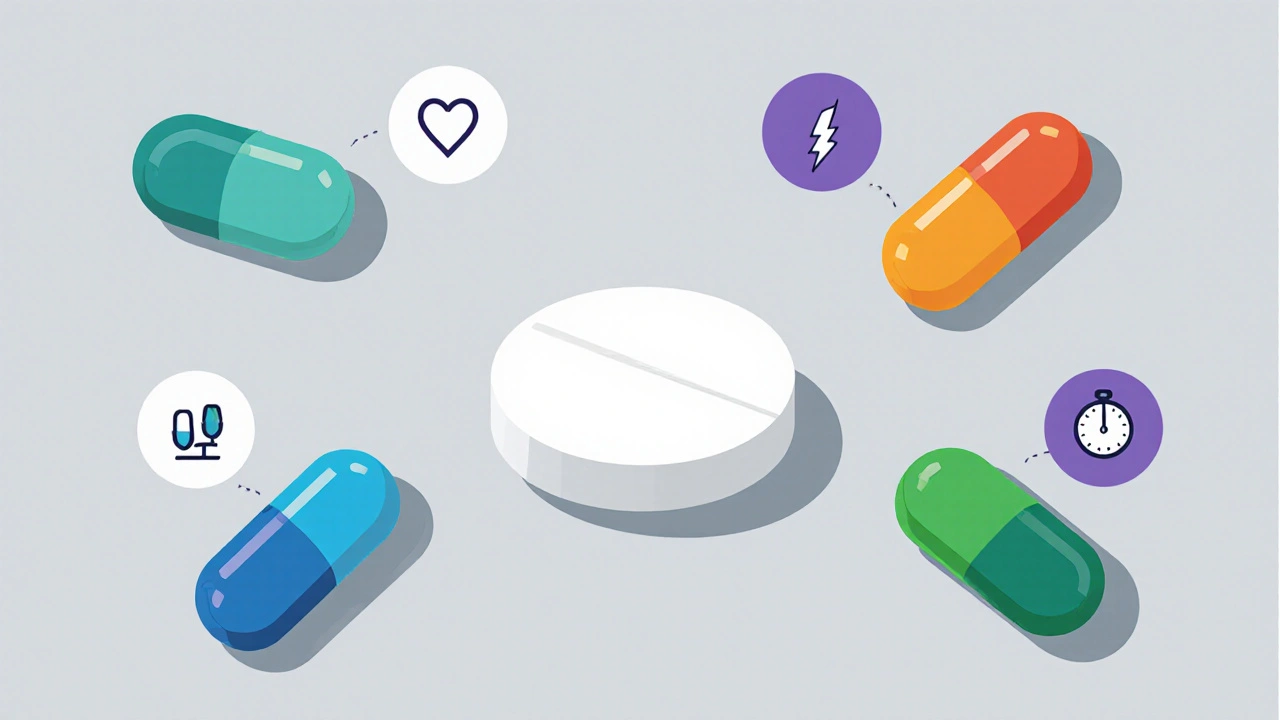

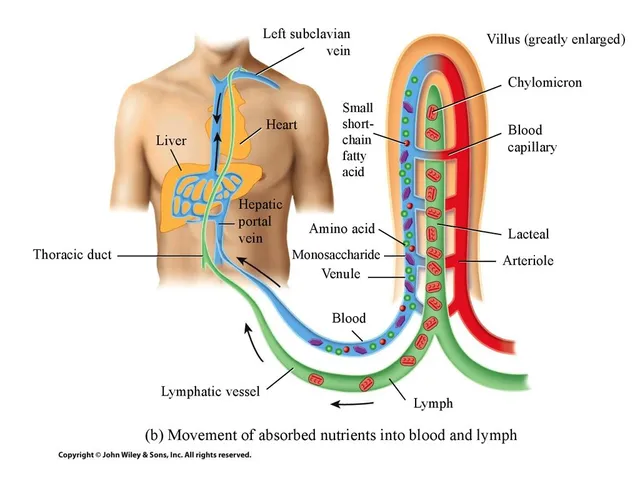
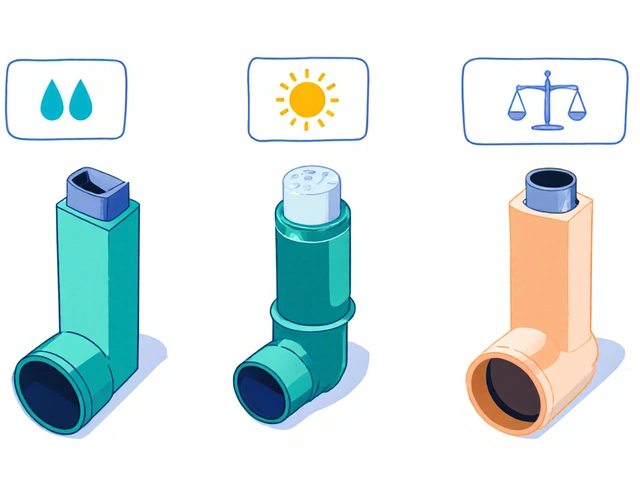
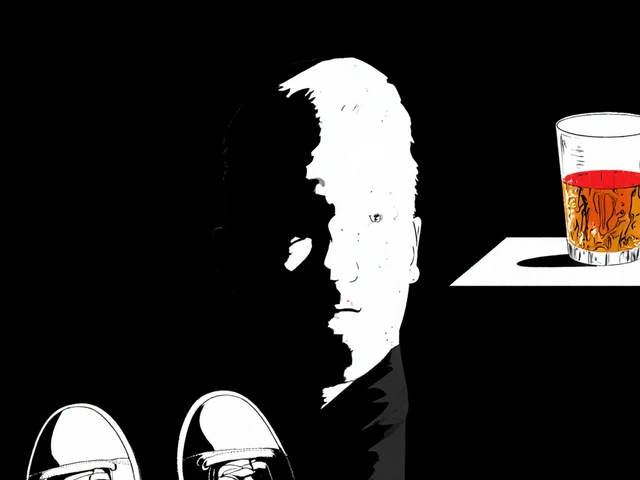

junior garcia
October 24, 2025 AT 15:25Celexa works well for folks who need a steady, low‑key lift without the jittery buzz of fluoxetine. Keep the dose under 20 mg if you’re over 60 to dodge heart rhythm issues. It’s cheap, once‑daily, and doesn’t mess with many other meds.
Dason Avery
October 25, 2025 AT 19:12Think of each antidepressant as a different path on the road to balance 🌅. Celexa offers a calm sunrise, while escitalopram pushes the sun a little higher, and fluoxetine keeps the night‑owl awake. No matter the choice, the goal is a steadier mood horizon. Stay hopeful, the right fit is out there.
Casey Morris
October 26, 2025 AT 22:59Celexa, as a racemic mixture, presents a modest efficacy profile; its pharmacokinetics, with a half‑life of approximately 35 hours, allow for relatively swift tapering, which many clinicians appreciate, especially when transitioning patients; however, one must remain vigilant regarding QT prolongation in the elderly, particularly at doses exceeding 20 mg/day.
Teya Arisa
October 28, 2025 AT 02:45In clinical practice, the selection of an antidepressant must align with the patient’s comorbid conditions, pharmacogenomic profile, and socioeconomic considerations. Celexa, given its favorable cost and minimal enzyme induction, often constitutes a judicious first‑line option for middle‑aged individuals presenting with uncomplicated major depressive disorder. Nonetheless, clinicians should conduct baseline ECG assessments in patients with cardiovascular risk factors to preempt potential QT interval extensions.
Carla Taylor
October 29, 2025 AT 06:32Celexa’s cheap and works fine for many.
Kathryn Rude
October 30, 2025 AT 10:19One must acknowledge that the psychopharmacological landscape is riddled with nuance. Celexa, the archetype of a modest SSRI, provides a baseline of serotonergic augmentation without the flamboyance of fluoxetine’s activating properties. Its modest side‑effect burden renders it suitable for the indecisive soul seeking equilibrium. Yet the modern patient, ever‑aware of sexual dysfunction, may gravitate toward bupropion or escitalopram. In the end, therapeutic harmony is a subjective concerto 🙂
Ekeh Lynda
October 31, 2025 AT 14:05Celexa occupies a peculiar niche in the antidepressant market. It is inexpensive and widely available. The molecule is a racemic mixture of two enantiomers that share the same serotonin reuptake inhibition. Clinical trials have demonstrated that its efficacy is comparable to other first‑generation SSRIs. The side‑effect profile is generally tolerable with moderate rates of sexual dysfunction. Weight change is negligible in most patients. Insomnia is reported less frequently than with fluoxetine. The drug is metabolized primarily by CYP2C19 and therefore interactions are limited. For patients over sixty the risk of QT prolongation becomes clinically relevant at higher doses. The FDA has therefore capped the recommended maximum at twenty milligrams for that age group. This dosage restriction actually simplifies prescribing because dose adjustments are rarely needed. Yet the same restriction can be perceived as a drawback when clinicians seek flexibility. The half‑life of approximately thirty‑five hours allows for relatively quick washout compared with fluoxetine. This short half‑life can be advantageous when switching medications. However, it also means that missing a dose may lead to a quicker decline in plasma concentration. Overall Celexa serves as a pragmatic option for many but it is not the ultimate solution for every clinical scenario.
Dahmir Dennis
November 1, 2025 AT 17:52Ah yes, the noble quest to pick the “perfect” pill while ignoring the root causes of misery. One could argue that prescribing Celexa is an act of kindness, but it also perpetuates a culture of chemical quick‑fixes. The pharmaceutical industry loves to parade cheap SSRIs as miracles, yet they conveniently ignore the societal pressures that drive depression. If we really cared, we would invest in community support rather than endless trade‑names. Until then, enjoy the illusion of progress.
Jacqueline Galvan
November 2, 2025 AT 21:39When evaluating Celexa against its alternatives, it is essential to consider efficacy, onset of action, and tolerability. Studies indicate that Celexa’s antidepressant effect emerges within two to four weeks, which aligns with the typical timeline for most SSRIs. Its side‑effect spectrum, particularly the moderate incidence of sexual dysfunction, is comparable to sertraline and less pronounced than fluoxetine’s activating properties. Cost considerations further favor Celexa, as generic formulations are among the most affordable options on the market. Clinicians should individualize therapy based on patient comorbidities, metabolic profile, and personal preferences.
Dawn Bengel
November 4, 2025 AT 01:25American drug development has delivered the most reliable antidepressants and Celexa is a prime example 🇺🇸. Anything else is just a foreign imitation that can’t match our standards. If you’re not on a US‑made SSRI, you’re settling for second‑rate treatment. Choose wisely, choose home‑grown.
HILDA GONZALEZ SARAVIA
November 5, 2025 AT 05:12Celexa’s efficacy is well‑documented regardless of its country of origin. Comparative data show that generic citalopram performs on par with many international formulations. While national pride is understandable, treatment decisions should prioritize clinical evidence and patient response over manufacture provenance. Cost‑effectiveness and accessibility often favor the generic versions available worldwide. Ultimately, the best medication is the one that aligns with the individual’s therapeutic goals.